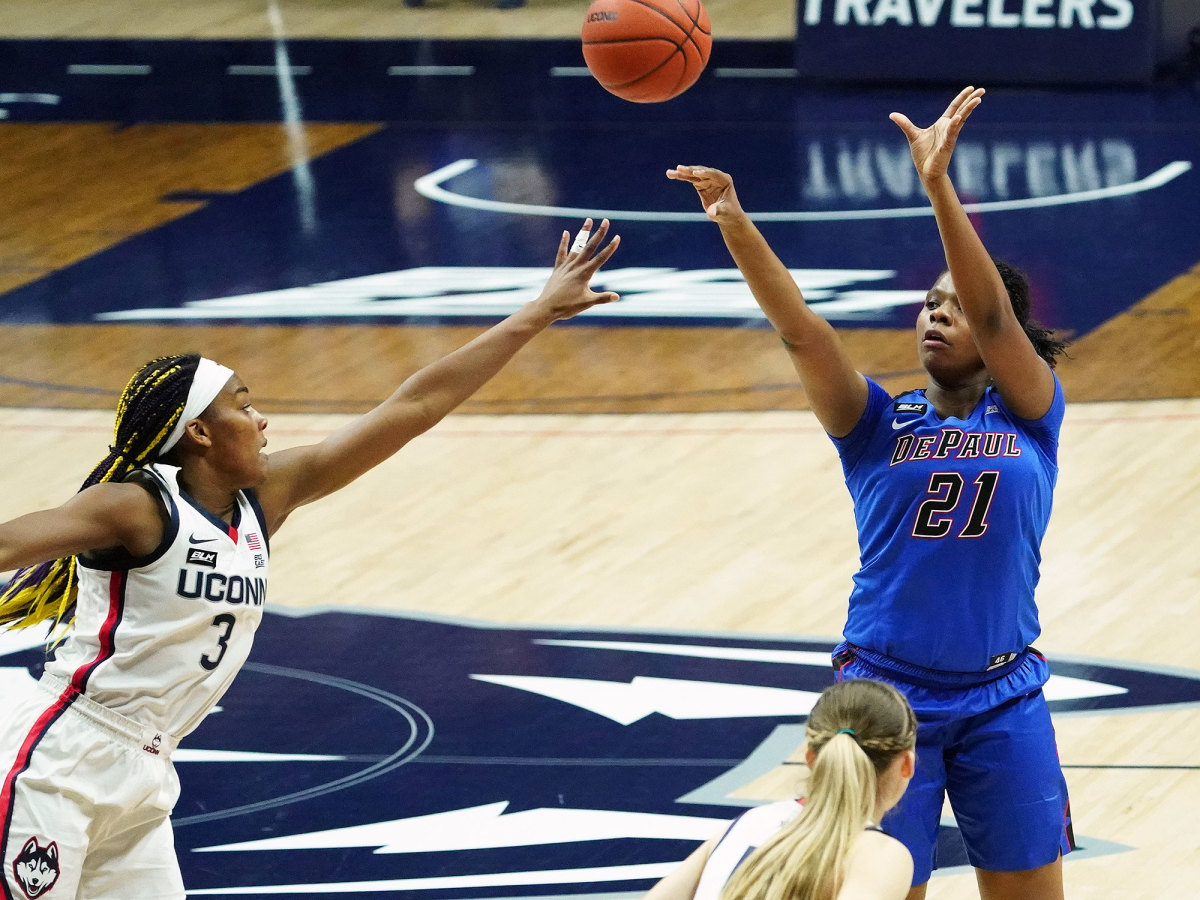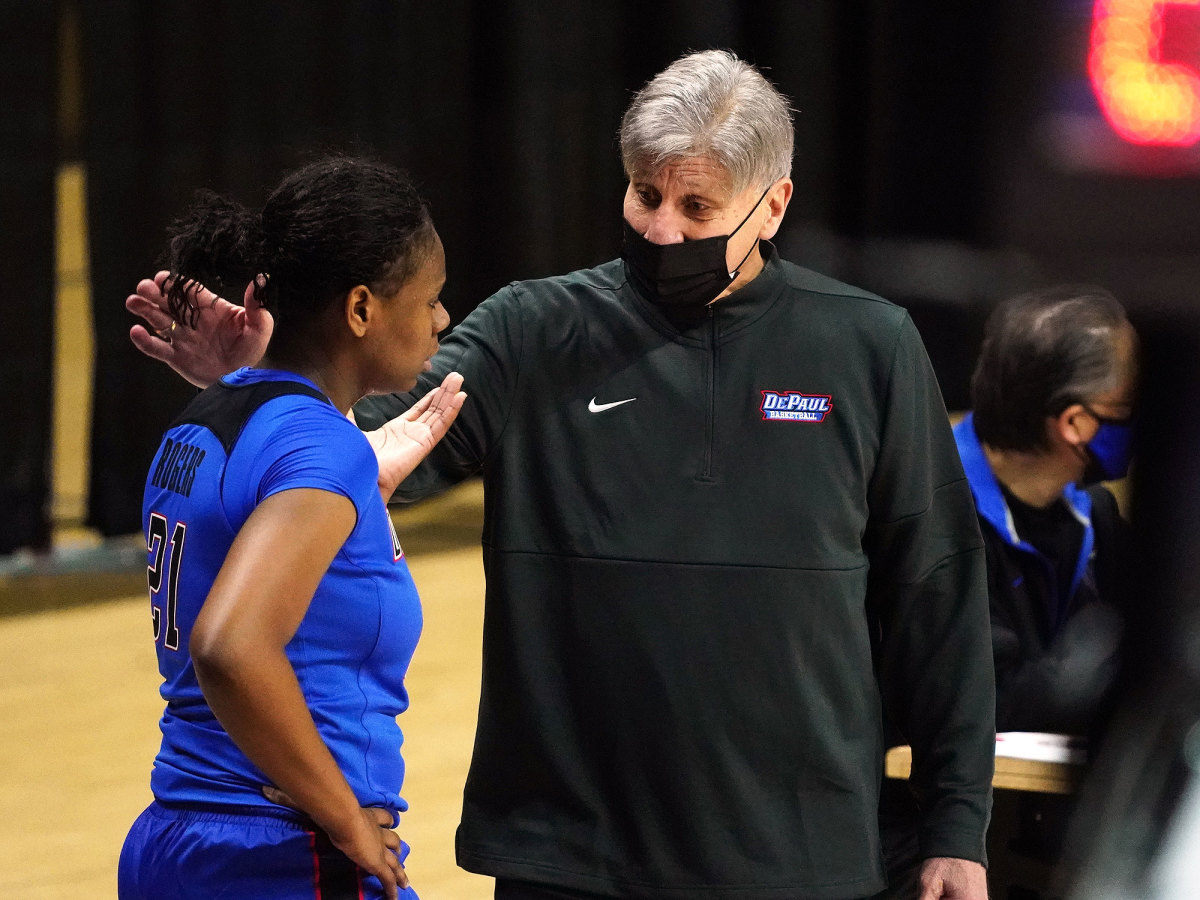‘The Greenest Green Light in America’: How DePaul’s Offense Became the Nation's Best

When Doug Bruno set out to coach DePaul 36 years ago, he had two goals in mind: make a Final Four and entertain people with women’s hoops.
While he and the Blue Demons are still working toward that first goal, they’ve achieved the second this season through Bruno’s progressive offensive philosophy, referred to in the program as “the greenest green light in America.”
“Offense sells tickets, defense wins games and defense and rebounding win championships,” he says, referring to Pat Summitt’s famous quote. “Yes, the ultimate goal is to win championships, but we are still trying to get people to watch women play basketball. … If you’re going to play a slow[ed] down, half-court, robotic style of basketball, that’s hard to watch when it’s the Warriors going against the Lakers.”

Bruno runs an offense that has ranked in the top 10 in scoring nationwide each season since 2013, averaging 82.7 points in the last eight. But this year, no other program has come near DePaul’s offensive production, as it leads the country scoring 90.2 points per game. With second-place Oklahoma averaging four points fewer, the Blue Demons’ offense has been the exemplar, elevating them to second in the Big East behind only No. 8 UConn—who they lost to by two points last month and face again Friday night.
DePaul has been a national name in women’s basketball since Bruno took over. He led the Blue Demons to 17 consecutive tournament appearances between 2003 and ’19, a feat that was matched by only Connecticut, Stanford and Tennessee. However, the historic streak came to an end last season, and DePaul has still never advanced past the Sweet 16.
The team hopes this season’s offense can be the difference-maker. DePaul Ball, as they like to call it, boils down to four key factors—three-point shooting, transition, half-court offense and rebounding. That hasn’t changed much from year to year, as Bruno’s system is one that doesn’t have to and can instead utilize the team’s strengths for that season. It just so happens that this year, his players excel in all four areas.
Since the three-point line was adopted in the 1980s, DePaul has been known for its success beyond the arc, and this season has been no different.
“You can’t have true offensive floor spacing if you don't have five people that can make a three,” Bruno says.
DePaul ranks fifth nationally in three-point attempts (620) and makes (219) and shoots them at a 35.3% clip. Senior guard Lexi Held accounts for more than a quarter of her team’s threes, making 44% on the year.
While the three-ball has played a crucial role in spreading the court, Bruno says his philosophy emphasizes getting to the rim for the highest percentage shot, which often comes in transition.
“The spacing exists to get the ball to the rim, but the best shot basketball is still going to be a layup,” Bruno says. “What I’m trying to figure out is how to score the highest rate of points per possession. You score the highest rate of points for possession in the open court, not in the half court.”
The Blue Demons average 21.7 points per game in transition—a quarter of their total output. Six times this season, they’ve scored more than 30 fast-break points. However, the remainder of their points come in the half court, so Bruno says his team must execute there as well.
While leading the nation in scoring is the flashier stat, the team’s goal each year is to rank first in assists—which they’ve done so far with 496 this season.
“I really believe the essence of the game of basketball is sharing and serving your teammates,” Bruno says. “Every pass to a teammate is a service project within the game.”
“We have a lot of freedom,” Held adds. “The only rule we have is to shoot it or share it. Other than that, he trusts us to play our game and make decisions. And we don’t have set plays that we run every time on the court.”
This stems from Bruno’s idea of ‘positionless basketball,’ in which each player on the court can play every position. Freshman forward Aneesah Morrow, senior guard Sonya Morris and Held all said this ideology played a significant role in their decision to choose DePaul, as well as the green light the coach gives those on the court. As a result of the philosophy, all five of his starters are averaging double digits, with seven players totaling six or more points a game.
“You can shoot it from anywhere. You can drive it from anywhere. He doesn’t try to limit your game at all,” Morrow says.

Positionless basketball leads to a better sense of camaraderie on the court, where no one player is taking an opportunity from another—instead, they are equals. This allows for a high sense of sharing, which can come in the form of assists or even rebounding.
“A simple thing that he says is that every shot is a pass,” Morrow says. “I look at every shot from my teammates or from the opponent as a pass to me.”
Bruno and his players believe rebounding has been the differentiating factor for them this season. The catalyst for that change has been Morrow, who’s made an immediate impact in her freshman year, leading the nation in total rebounds, rebounds per game, offensive rebounds per game and double doubles.
“She’s basically acting in a cleanup role,” Bruno says. “She’s not coming in here as the new No. 1 chef. She’s coming in here and cleaning up the kitchen. So she’s not detracting or taking anything from what the other players do. She’s helping them do what they do.
“That offensive rebounding factor does so much because it also frees up the psyches of the shooters,” he adds. “They don’t have to have as much pressure on them. That pressure to make a shot becomes mitigated when they know they have somebody backing them up to get an offensive rebound.”
In her first 25 college games, Morrow has averaged 20.1 points and 13.3 rebounds, recording 20 double doubles on the year and 17 straight. She’s won 11 consecutive Big East weekly awards, including Freshman of the Week every week except the last.
The combination of three-point shooting, pushing the pace, positionless half-court play and rebounding by one of the best freshmen in the nation has allowed DePaul to reach new offensive heights this season.
“Coach always says the offense will work if the players make the offense work,” Morris says. “If they take one option from us, we’ll have another option because that’s how the offense is and us as individual players are. We’ve got the skills, talents and capabilities to adjust to the defense or what the defense took from us.”
The offensive recipe may be set, but on defense, DePaul still has room to grow. The Blue Demons give up 75.8 points per game, which ranks 343rd out of 356 Division I teams.
“We are trying to defend you. We are trying to stop you,” Bruno says. “But because we give you the ball back more often, and because we shoot it quickly ourselves, it’s harder to defend when you play the way we play because you’re on defense more often.”
But the Blue Demons refuse to use their high-speed offense as an excuse to slack on the other end.
“Since we are a team that averages the top amount of possessions in the nation, it’s easy for us to take some possessions off [on defense] because we know that we’re going to have the ball again,” Held says. “I think that the biggest thing for us is to just focus on defense every possession. … I think we can be a really strong defensive team if we just value it as much as every other aspect of our game.”
As March is just a few weeks away, the NCAA tournament is approaching—a place where Bruno has been many times before. He and his players know this year’s team has the talent to make a run, but to go all the way, they’re going to need to let their offense do its thing and focus their attention on the other end of the court.
“The beauty of the tournament is the drama of the closeness of each game,” Bruno says. “You better be able to make stops, and you better be able to rebound, and you better be able to execute on both sides of the basketball to survive.”
Reaching the Final Four still remains one of Bruno’s career goals and improved defense may be the key to helping his team get there, but that won’t stop him from continuing to bring the sport the attention it deserves.
“These women play great basketball,” Bruno says. “But it’s hard to get people to watch them play basketball. … Selling tickets to watch women play basketball is important. It’s not a higher priority than winning games or championships, but it still is a priority.”
More College Basketball Coverage:
• Body of a Lineman, Game of a PG: Meet David Roddy
• Indiana WBB Has Much More It Wants to Prove
• Loyola's Williamson Finds Passion in Project on ’63 Title
